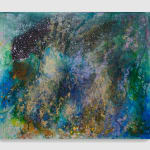-
Artworks










La Sirène (Describing the West India Navigation, from Hudson's-Bay to the River Amazones), 2022
Oil and acrylic on archival printed canvas73 7/8 x 60 7/8 in.
187.5 x 154.5 cm$ 210,000.00SoldFurther images
-
(View a larger image of thumbnail 1
)

-
(View a larger image of thumbnail 2
)

-
(View a larger image of thumbnail 3
)

-
(View a larger image of thumbnail 4
)

-
(View a larger image of thumbnail 5
)

-
(View a larger image of thumbnail 6
)

-
(View a larger image of thumbnail 7
)

-
(View a larger image of thumbnail 8
)

-
(View a larger image of thumbnail 9
)

-
(View a larger image of thumbnail 10
)

This painting by Firelei Báez, entitled Haitian Mermaid (Describing the West India Navigation, from Hudson's-Bay to the River Amazones), is a response to the nautical Afrofuturist mythology developed by Drexciya,...This painting by Firelei Báez, entitled Haitian Mermaid (Describing the West India Navigation, from Hudson's-Bay to the River Amazones), is a response to the nautical Afrofuturist mythology developed by Drexciya, a Detroit-based electronic music duo. In the 1990’s, sleeve notes accompanying their techno albums described an underwater nation called Drexciya populated by a new generation of water-breathing humans: the unborn children of pregnant African women who were thrown off of slave ships and had adapted to breathe fluid within their mothers’ wombs. Here, Báez expands upon Drexciya’s counter-narrative with rich layers of abstract gesture—along with subtle hints of figuration—opening up the inherited story of the transatlantic slave trade to new interpretations and generative possibilities.
Beneath this immersive painting by Bâez lies a reproduction of a map from 1794 entitled “A Correct Chart of Hispaniola with the Windward Passage,” which describes the navigation of the West Indies. Taken from a major sea-atlas published in England, the map illustrates trade routes across the Caribbean region that circulate not only commodities and bodies, but also ideologies and revolutionary precedent.
Exhibitions
James Cohan Tribeca, Americananana, October 27 – December 21, 2022
Literature
Publications
Liebert, Emily and Rivera Fellah, Nadiah, Picturing Motherhood Now, New Haven and London: Yale University Press, 2021. -
(View a larger image of thumbnail 1
)









